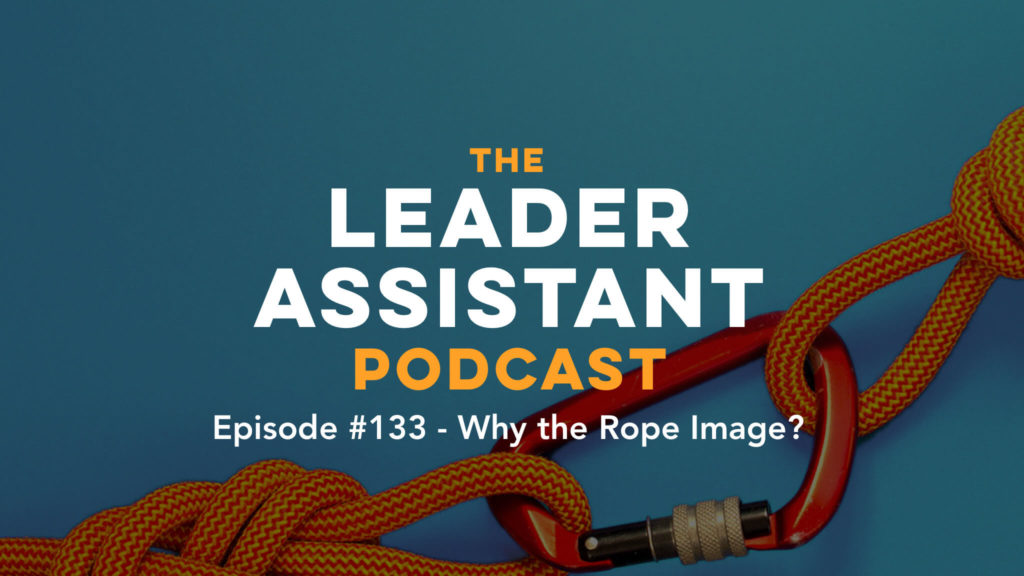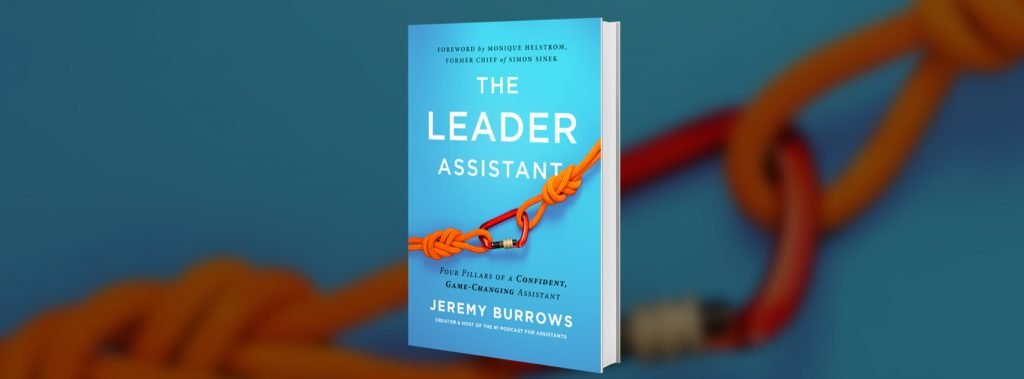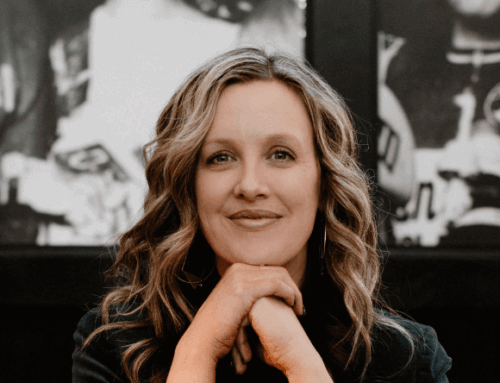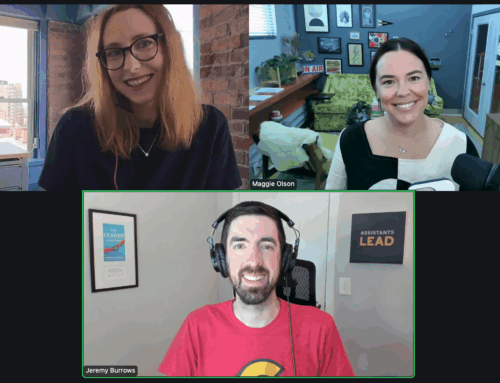Ever since my book, The Leader Assistant came out, people have asked me why I chose to use an image of a climbing rope and carabiner for the book’s cover.

Well, I’m glad you asked. In this episode, I share a recording from my book (The Leader Assistant) launch party where I walk through the multiple meanings of the rope and carabiner image. I also share a quick overview of the entire book, so I hope you enjoy it!
Oh, and check out the video of my overview here to see the slides as well.
CONNECT WITH ME
ABOUT ME (JEREMY BURROWS)
I’m a longtime executive assistant, international speaker and trainer, founder of The Leader Assistant Community and Premium Membership, author of the #1 Amazon Bestselling book, The Leader Assistant: Four Pillars of a Confident, Game-Changing Assistant, and host of the #1 podcast for assistants – The Leader Assistant Podcast.
I’ve worked with CEOs, professional athletes, Fortune 100 board members, billionaires, pastors—and their assistants—in both the nonprofit and for-profit sectors.
I’ve also had the opportunity to speak at administrative professional and executive assistant conferences all over the world, including Hong Kong, Thailand, and Germany.
I’m currently EA to the Founder and CEO of Capacity, a fast-growing artificial intelligence SaaS startup with an AI-powered, support automation platform.
My passion is to help you lead well, resist burnout, and automate before you’re automated.
I live in Kansas City, MO with my amazing wife and 2 boys. My hobbies are podcasting, beer, music, stocks, and entrepreneurship.
THE LEADER ASSISTANT PREMIUM MEMBERSHIP
To learn more about how you can join the now 200+ growth-minded Leader Assistants, check out our Leader Assistant Premium Membership for ongoing training, coaching, and community.
LEADER ASSISTANT LIVE EVENTS
Check out our constantly updated schedule of events for admins and assistants at LeaderAssistantLive.com.
THE LEADER ASSISTANT BOOK
Download the first 3 chapters of The Leader Assistant: Four Pillars of Game-Changing Assistant for FREE here or buy it on Amazon or Audible.
JOIN THE FREE COMMUNITY
Join the Leader Assistant Global Community here, or the Facebook Group here for bonus content and to network with other assistants who are committed to becoming leaders!
SUBSCRIBE
Subscribe to The Leader Assistant Podcast so you don’t miss new episodes!
You can find the show on Apple Podcasts, Spotify, Google Podcasts, Pandora, and Stitcher.
Join my email list here if you want to get an email when a new episode goes live.
LEAVE A REVIEW
If you’re enjoying the podcast, please take 2 minutes to rate and review the show on Apple Podcasts here. Each review helps me stay motivated to keep the show going!
—
EPISODE TRANSCRIPT
Podcast Intro 0:00
Welcome to The Leader Assistant Podcast. The Leader Assistant Podcast exists to encourage and challenge assistants to become confident game changing leader assistants.
Jeremy Burrows 0:16
Hey, friends, thanks for tuning into The Leader Assistant Podcast. It’s your host, Jeremy Burrows, and it’s Episode 133, how to check my notes real quick slot episodes. So we are going to hear a clip from my book launch party from I think it was June of 2020, where I talk about the book cover image, and you’ll have to check out the show notes at leaderassistant.com/133. That’s leaderassistant.com/133. And I’ll actually include the video that includes my slides for this talk. But you can also see the book cover there and see this rope carabiner image that I refer to. And I got some questions about why the rope image why the carabiner? Why did you choose that image for the front cover of this book for assistance? And so I answered that question in my book launch party and wanted to share the recording with you. In case you missed it. And in case you’re curious, I think it’s an it’s a good image to use that has multiple meanings. And yeah, I hope you enjoy this quick overview. But then I also talk about once I get through the rope image conversation, I talked about just an overview of the whole book. And it’s, it’s short, I think it’s 10 minutes or so. But I kind of walked through the process of writing the book in what I included in each section. So I would really encourage you to listen to this overview. And if anything, piques your interest, check out the book on Amazon or Barnes and Noble or walmart.com, or wherever you like to get books or the audio book, like you heard last week in Episode 132, an excerpt from the audio book. So yeah, check out the show notes for a link to all of those places, leader assistant.com/ 133. And again, the video of this recording that you’re gonna hear that includes my slides will be linked in the show notes at leaderassistant.com/133. All right, enjoy it, and we’ll talk to you next time. Why the rope image? So yeah, I’ve had a few people ask, some people were like, This doesn’t make sense, you know, so I wanted to kind of just share a few points as to why I chose this image. Other than the fact that it looks really good on the on the cover is from a design perspective, in my opinion. So as assistance, we we manage tension, there’s, there’s always this constant push and pull. And so I liked the rope, because it kind of shows like, We are the carabiner that kind of maintains that balance in a lot of different ways. And so there’s this, this just tension and tug. But there’s this steady, strong assistant in the middle of the crazy work environments that we that we work in. And then we also kind of like I said, with the carabiner we kind of hold everything together, you know, without us it kind of just goes wherever our executives do whatever they want, company suffers. And then guide and support. So if you if you’ve never been rock climbing, whether at like a, at a gym, or actually out on a real rock with with rope rope climbing, you’ve got what’s called a lead rope. And so there’s there’s a spotter at the bottom that’s holding the rope and they’re anchored in and they basically as you climb higher they lead out a little bit more rope and then if you fall they kind of can gank on the on the unlock the rope in so that you don’t fall further than you would like to fall. So the other kind of tie in with the rope was that we as EAS are like our executives are up on the wall and they’re trying to try to bring their company to you know this the sales numbers or they want to sell the company Sunday and there’s these goal all these goals that the executives trying to to meet. And we’re like that lead rope spotter at the bottom that is holding on and but it’s not just holding on to them and supporting them. What do the spotters do that are, you know helping somebody climb? They look ahead and they say oh your right foot put your right foot They’re Oh, put your left arm up about 10 inches above your head, because you can’t always see unless you’re sitting back and you’re down there at the lead rope. So I loved that tie in as well, because I think that’s what assistance we’re leading. We’re guiding them, we’re not just supporting them, but we are also supporting them. So we’re the eyes to our executive as they try to reach their goals. And then the last one is there was kind of the prologue for those of you who have read the prologue was a story about my my brothers and I and my dad hiking on glacier mountain glacier in Colorado. And my brother slipped and fell into a crevasse and disappeared, and we thought he was gone. So it was just this, this kind of story that I use that I then tie to my kind of career glacier in the book. And anyway, we didn’t have the gear, we didn’t have the equipment that we needed on that, that day and that track. And so this was kind of another time where it’s like, okay, this is kind of like a climbing rope or a hiking equipment, tie in where we want to be able to support the executives, but we also need support, we also need the right equipment we also so the other the other guidance and poor analogy I like is assistant to assistant. So it’s not only were the lead rope, helping our executive up up the wall, we’re an assistant helping an another assistant up the wall, where we are, we’re trying to reach our career goals. And so that’s why I kind of tie that in. So hopefully that makes sense. anybody asks, that’s why that’s why I did the rope. And I’m excited for the cover, I had a really great designer team named Aaron Tyler, she was she was great and very excited about that. So just a quick overview of the book, it’s called the subtitle is four pillars of a confident, Game Changing leader assistant. And the four pillars, I’ll just kind of go through the four pillars. So the first pillar pillar, I talked about embodying the characteristics. And so what I kind of learned my my quick version of my story is I’ve been an executive assistant for 13 years or so. And after about nine years, my, my prior executive got fired, burned out, I burned out, I decided to leave that organization and kind of hit reset. And one of the things that I realized was poop, because people used to say, oh, man, you’re such a good assistant. And you’re, you’re like The Rock, you’re like, the honey badger, you don’t care, you just get stuff done. And I was just like, all right, I’m awesome, you know. And then when I left, I was like, I didn’t have any network, I was burned out. So then I started meeting other assistants. And it was like, I gotta, I gotta network. And I started realizing that I was like, behind, like, I didn’t really know what it meant to be a game changing assistant, I just knew what it meant to be like a solid, you know, good assistant. So what I did in this pillar, is I kind of outline 18 essential characteristics. It’s kind of an overwhelming list. But it’s, I was trying to be quick with that list. And also realistic, because I know that assistance require a lot of different things. But then what I did was I zoomed in on the five game changing characteristics.
And those were the ones that I really feel I was missing a lot of in my last role in that what kind of makes those leader assistants really stand out from the, from the rest of the pack. So these are the five game changing characteristics, discerning, steady, confident, humble, and future proof. So I kind of walk through each of these in the book, and just I really feel strongly about if these, you know, we need to, we need to embody all the characteristics. But these are the ones that we can really lean into, and really help us become a game changing EA, that our executive and really the world needs. So the second pillar is employ the tactics. So what I didn’t want to do is I didn’t want to talk about specific tools, because the tools always change between jobs, they change every couple of years, there’s new tools. So my kind of whole philosophy is that the tools you use don’t really matter if the tactics you employ are flawed. And so what I tried to do is I tried to walk through all the different things we deal with time management, calendars, email, travel communication, interruptions. on goal setting, which Julian Hufnagel, who I think is on the call, she, she wrote that chapter, which was awesome negotiation. Al Hussein, Matt Haney helped with that chapter, resume all these different areas and I just tried to focus on the tactics. And then you can take those tactics and apply them to whichever tools you use. So that’s kind of the, that’s the practical like hands on. Like, here’s how I manage my calendar, here’s how I manage email, here’s how I manage my executives, you know, travel, whatever. So that’s, that’s the pillar two, then we get into the fun stuff, the relationships, so engage in relationships is pillar three. And this is where I failed, I did not have a network, I literally only knew one assistant, outside of my company, and we only had one other assistant inside my company. So I really didn’t have a network of assistants at all, I wasn’t on LinkedIn, I wasn’t doing anything. And that really, really hurt when this whole thing happened. And my boss got fired. And I’m just like, What do I do, I just, I just had no support network to lean on. So I talked about the importance of growing your assistant network. And then I also talked about the other relationships, like the relationship with your executive. So a lot of you have micromanagers, as executives, a lot of you have executives who you’ve tried to lead, but they’re very resistant. So I tried to help you share things that have helped me break through those barriers with executives who are resistant to change. And then I talked about co workers and how we should really just just kind of these D human humanization of assistants that the experiences that we have, where people like coworkers, you think they’re wanting to be your friend you think they want to get close to, and then you find out that oh, they just wanted to find out the information from your your boss, or they just wanted to know how your executive is doing. And these things are really, these are real experiences that we deal with all the time as assistants. And so I process through how I dealt with that. And what I’ve tried to do, and I really, I honestly just kind of share that I’m still kind of trying to figure out, do I do a I don’t want to be best best buds with all my co workers. But I also don’t want to be a jerk in the corner that doesn’t talk to anybody. So like, I’m still wrestling with that dynamic. But just being self aware of those instances of dehumanizing interactions is valuable. Then I go to the last pillar. So this is kind of the most important pillar in a lot of ways. Because you can be a really good leader, Assistant, practically and produce and on paper, you’re great. But then you’ll end up burned out like I was where you’re, you know, quick to anger, you’re unpleasant to be around, you just don’t have any. You haven’t done anything to kind of cultivate your creativity, because you just you’re just work, work, work, work work. So I talked about a few things in this pillar, I first talked about burnout creep, and how it just kind of seeps through the wood floors. And you may not notice it. And so becoming self aware, and helping you become self aware about the burnout creep that might be happening in your life. I talked about the signs and stressors. So the stressors are the things that are probably happening, or could be happening in your role that could drive you to burnout. And the signs are like, Alright, I’m already on the way or I’m already burning out. These are the signs that that you might be burning out. And then I talked about antidote. So what helped me kind of come out of that burnout, reset, refresh, get healthier, and what helps me on, you know, on an ongoing basis, avoid burnout. And really, I’d say avoid, but it’s I’m still trying to train myself to not say avoid, because I used to say that all the time. You know, here’s how to avoid burnout. Honestly, I don’t think that it’s possible to avoid burnout. I think that burnout happens to everyone. It’s just a matter of how serious it is. And so what I do think we can do is we can fight against burnout, and we can resist burnout. And so we can limit the damages of burnout. So that’s kind of what I talked about in pillar four. So embody the characteristics, employ the tactics, engage in relationships, exercise, self care. I had a couple people post on LinkedIn saying they they sat down and read it one sitting you It’s I tried to make it. I hired a really good copy editor to just beat the crap out of it. And just like delete this delete, cut this down. I tried to make it a really clear, succinct guide for you all. So I hope you enjoyed that overview from over a year ago. I’m still passionate about all those topics and I hope you have been able to check out the book. Check out leaderassistant.com/133 to see the video of that presentation with the slides and the book cover image and all that will talk to you soon.
Podcast Intro 15:48
Please listen you on Apple podcasts. Goburrows.com






